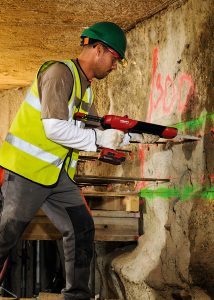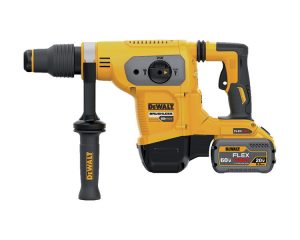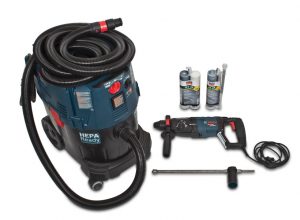
New products and regulations are on tap for the concrete anchoring sector
By Nate Hendley
Concrete Construction anchoring anchoring solutions concrete fastenersThe next few months will see new concrete anchoring product releases and new U.S. regulations about using such products. Power tool companies that sell concrete anchoring solutions will be displaying their wares at World of Concrete, scheduled January 17 – 20, 2017 in Las Vegas.
“We plan on showing our new Speed Clean System with hands-on product demos,” says Fred Tai, engineering manager at Simpson Strong-Tie Canada, which has operations in Maple Ridge, B.C. and Brampton, Ont.
Developed with Bosch, the Speed Clean DXS Dust Extraction System decreases dust while producing clean, precise holes for adhesive anchor installation. DXS System drill bits can work in conjunction with common vacuum systems and rotohammers for concrete drilling. With the DXS, construction workers don’t have to clean out anchoring holes in traditional blow-brush-blow fashion, thereby reducing airborne silica dust—an important consideration, given pending industry rules.
There will be several products from the Maryland firm now known as DeWALT Engineered by Powers in Vegas, including AC 200+ adhesive, the Hollow Drill Bit (HDB) and the FLEXVOLT SDS Max Rotary Hammer.
AC 200+ is “the big product we’re introducing to market … it’s a fast-cure adhesive with all the approvals for cracked concrete and uncracked concrete,” says Sean Agresta, a field engineering manager for Stanley Black & Decker Canada, in Mississauga, Ont.
Stanley Black & Decker is DeWALT’s parent company.
Other soon-to-be released DeWALT products include the Mini-Undercut+ and Hangerworks.
The Mini-Undercut+ is “a shallow embedment anchor that can be used in seismic/cracked concrete applications with only a ¾ inch embedment … Currently if an engineer/contractor needs to anchor into a PT (post-tension) slab and required the above qualifications, they would need to scan the concrete first before drilling, since the minimum embedment for a typical qualified anchor would be beyond where the cables are generally positioned. It’s a very serious structural and safety concern if one of these cables were drilled through … The Mini-Undercut+ has been designed with a stop drill bit to prevent over drilling,” says Agresta.
Hangerworks is a proprietary Autodesk Revit software plug-in that allows designers to plot where to place anchors and “figure out point loads, seismic loads, calculate what size anchor, how many … [the designer] can also determine what size strut he needs, what size rod he needs, what spacing, etc.,” he continues.
Hilti North America is launching several products next year, including, “the new Kwik Cast single point cast in place anchor [for] our mechanical and electrical contractors who prefer to cast in their anchors for hanging pipe and strut … The notched T-bolt system for our HAC cast in anchor channel product, which is the first cast in channel system with ICC approval for lateral seismic loads … The KB-VTZ, an economical stud anchor for seismic and cracked concrete, and an upgrade to the HIT-HY 200 product, which will bring on average 20 per cent higher loads in cracked concrete, grout-filled block ICC approvals, and a category 1 rating for installation into water saturated holes. This means, with the HIT-HY 200 and RE 500 V3, Hilti will be the only manufacturer with a slow cure and a fast cure product that do not have reductions in loads when used in jobsite conditions involving water saturated holes,” says Robert Dettman III, anchor BU manager for Hilti North America, headquartered in Plano, Tex.
A big part of Hilti’s focus at the World of Concrete will be on existing products such as HIT HY-200 anchoring adhesive system and HIT-RE 500 V3 epoxy adhesive system.
Hilti wants to highlight these products’ ability “to resolve the new standards from OSHA for silica dust on jobsites,” explains Dettman.
The new standards, from the Occupational Safety and Health Administration in the U.S., are designed to reduce workers’ exposure to silica dust kicked up during construction. According to OSHA, inhaling crystalline silica particles can lead to silicosis, lung cancer, kidney disease and chronic obstructive pulmonary disease.
The OSHA requirements take effect for construction sites June 23, 2017. While these regulations concern the United States, they will obviously impact Canadian firms working south of the border. There is also the possibility similar regulations might be adopted in Canada.
“Chemical anchors require you to blow out and brush the holes to properly clean the hole before anchor installation and this creates silica dust. The new OSHA requirement requires you to capture this dust … for blowing out drilled holes [the rules] require the use of a HEPA filter to capture the silica dust. While these standards may not apply to our Canadian markets yet, we know that many contractors will want to make sure they meet the latest safety standards available,” states Dettman.
Tai says some B.C. contractors are already “being asked to submit a dust management plan to deal with silica dust that is generated during the installation of concrete anchors.”
He has observed another west coast trend: “In seismic zones, drop-in anchors are not permitted to be used in overhead conditions. That is explicit in the design code that came into effect two code cycles ago. However, implementation has been lacking in B.C. The trend in the last couple of years by the building department is to rigorously enforce this requirement. The alternative anchor that meets the new code requirement is more of a wedge style anchor that meets the cracked concrete requirement and also has ULC listing for hanging sprinkler pipes,” states Tai.
Companies sometimes adapt their concrete anchoring systems to account for Canadian weather.
“Hilti always keeps the needs of Canada and the northern United States in mind when developing our chemical anchors, which is why our systems are specifically developed to be used in the coldest installations. Our HIT-HY 200 chemical anchoring system can be installed in temperatures down to 14 degrees F (-10 C). Our HIT-RE 500 V3 product can be installed down to 23 degrees F (-5 C), which makes it the first and only epoxy anchoring system that can be installed below freezing temperatures. Hilti also offers a special chemical anchor for when the temperatures get really cold. HIT-ICE can be installed in temperatures down to -10 degrees F (-23 C),” says Dettman.
“Cold climates normally do not affect mechanical anchors. However, adhesive anchors are affected by installation temperature. The cure times are affected. Simpson offers two different adhesive anchors, one for cold weather and one for [warm weather]. AT-XP is our cold weather anchoring adhesive for concrete anchoring of both threaded rods and rebar dowelling,” says Tai.
Designed to be used with cracked and uncracked concrete and masonry, AT-XP is a high-strength acrylic adhesive that cures in temperatures as low as 14 degrees F or -10 degrees C in 24 hours.
Canadian contractors are putting such products through their paces.
Hilti’s HIT HY-200 adhesive system is being used for anchoring applications in a construction project that’s transforming Sutton Place, a one-time legendary Toronto hotel, into luxury condominiums. Hilti also has a presence in construction work at Toronto’s Union Station.
“We had many applications [at Union Station], but the main two were RE 500 V3 for rebars and HY70 for attachment to a terracotta tiled ceiling,” reports Dettman.
DeWALT concrete anchoring adhesive products are being used for repair projects on the Jacques Cartier Bridge, Champlain Bridge and Olympic Stadium in Montreal.
“All three are having some major work done on them at this point,”
states Agresta.







